The Samsung 960 Pro (2TB) SSD Review
by Billy Tallis on October 18, 2016 10:00 AM ESTSequential Read Performance
The sequential read test requests 128kB blocks and tests queue depths ranging from 1 to 32. The queue depth is doubled every three minutes, for a total test duration of 18 minutes. The test spans the entire drive, and the drive is filled before the test begins. The primary score we report is an average of performances at queue depths 1, 2 and 4, as client usage typically consists mostly of low queue depth operations.
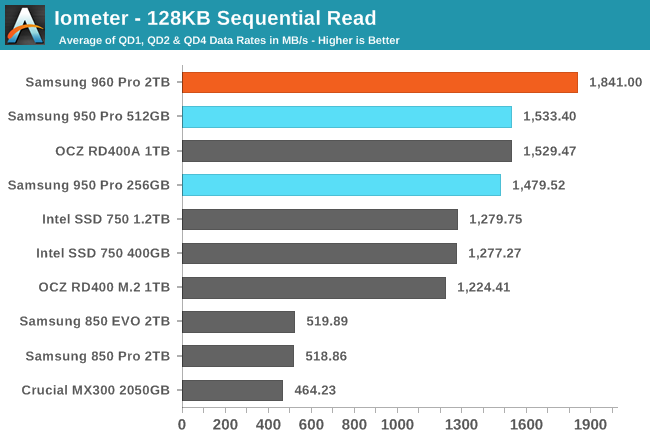
The 2TB 960 Pro's low queue depth sequential read speed is about 300MB/s faster than the 950 Pro, once again giving Samsung the clear lead in performance and showing that the 960 Pro is significantly better than the 950 Pro where thermal limits are a factor.
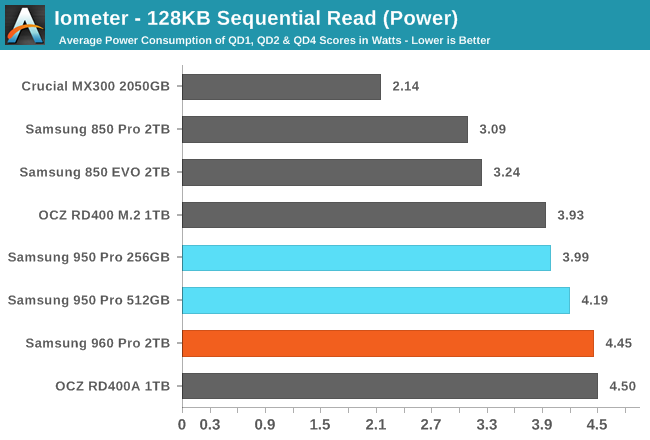
The 960 Pro consumes more power than its predecessors, but given the high performance it is the most efficient drive for this workload.
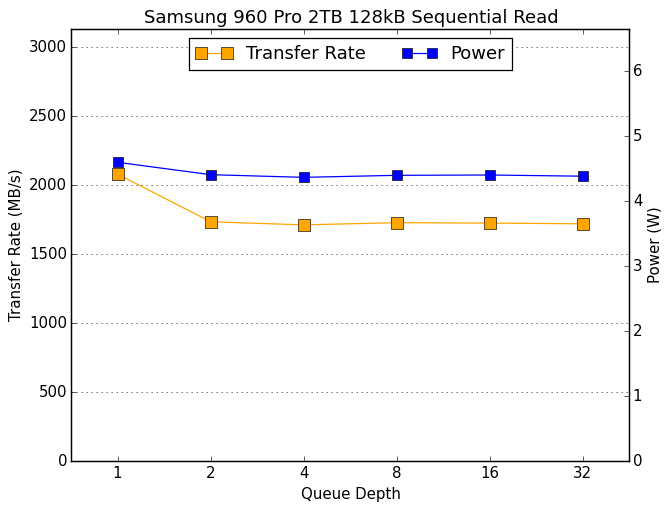 |
|||||||||
The slight drop in performance beyond QD1 indicates that the 960 Pro is still thermally limited for most of this test, and that like the 950 Pro it may perform much better with a heatsink.
Sequential Write Performance
The sequential write test writes 128kB blocks and tests queue depths ranging from 1 to 32. The queue depth is doubled every three minutes, for a total test duration of 18 minutes. The test spans the entire drive, and the drive is filled before the test begins. The primary score we report is an average of performances at queue depths 1, 2 and 4, as client usage typically consists mostly of low queue depth operations.
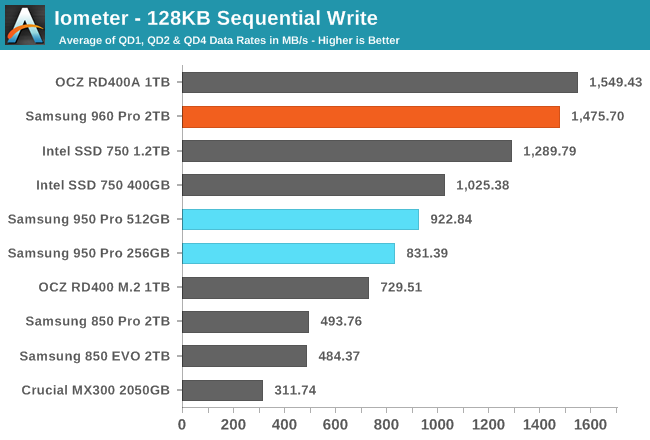
Thermals are an even bigger factor for the sequential write test than for sequential reads. The 960 Pro is 60% faster than the next fastest M.2 SSD and almost catches up to the RD400A with its thermal pad behind the controller allowing it to use its adapter card as a heatsink.
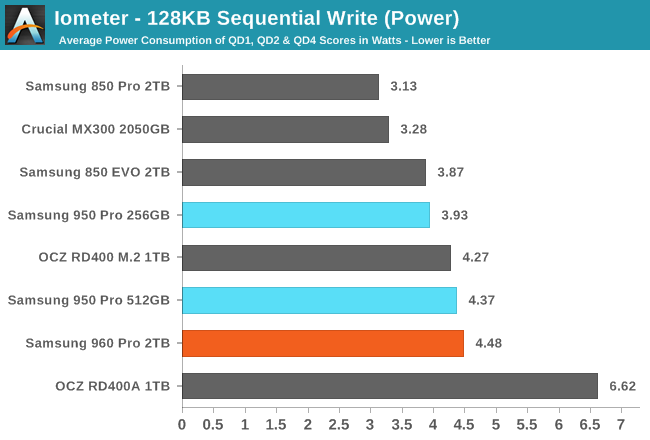
The 960 Pro's power consumption is only slightly higher than its M.2 competitors and far less than the RD400A. Given the performance, this makes the 960 Pro by far the most efficient SSD on this test, with about 30% higher performance per watt than the next most efficient drive.
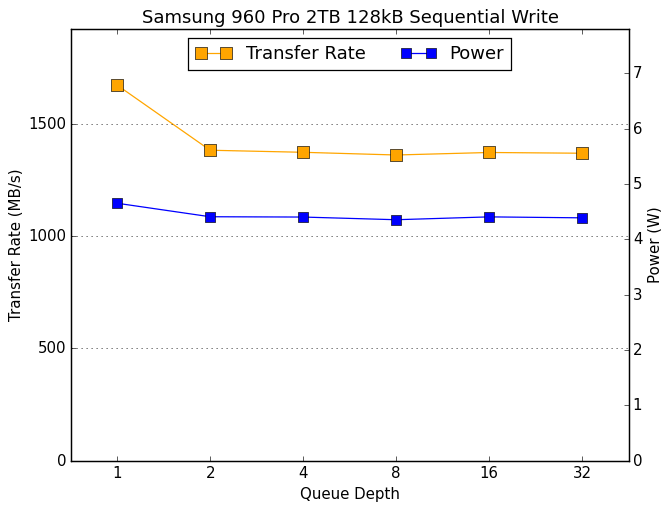 |
|||||||||
The QD1 performance of the 960 Pro is substantially higher than during the rest of the test where the drive is continuously thermally limited. The power consumption is only slightly higher at QD1 as the drive is able to spend a bit more power before its temperature gets up to the limit, then the drive reaches equilibrium at around 4.4W.










72 Comments
View All Comments
emn13 - Wednesday, October 19, 2016 - link
Especially since NAND hasn't magically gotten lots faster after the SATA->NVMe transition. If SATA is fast enough to saturate the underlying NAND+controller combo when they must actually write to disk, then NVMe simply looks unnecessarily expensive (if you look at writes only). Since the fast NVMe drives all have ram caches, it's hard to detect whether data is properly being written.Perhaps windows is doing something odd here, but it's definitely fishy.
jhoff80 - Tuesday, October 18, 2016 - link
This is probably a stupid question because I've been changing that setting for years on SSDs without even thinking about it and you clearly know more about this than I do, but does the use of a drive in a laptop (eg battery-powered) or with a UPS for the system negate this risk anyway? That was always my impression, but it could very much be wrong.shodanshok - Tuesday, October 18, 2016 - link
Having a battery, laptops are inherently safer than desktop against power loss. However, a bad (or missing) battery and/or a failing cable/connector can expose the disks to the very same unprotected power-loss scenario.Dr. Krunk - Sunday, October 23, 2016 - link
What happens if accidently press the battery release button and it pops out just enough to lose connection?woggs - Tuesday, October 18, 2016 - link
I would love to see Anandtech do a deep dive into this very topic. It's important. I've heard that windows and other apps do excessive cache flushing when enabled and that's also a problem. I've also heard intel SSDs completely ignore the cache flush command and simply implement full power loss protection. Batching writes into ever larger pieces is a fact of SSD life and it needs to be done right.voicequal - Tuesday, October 18, 2016 - link
Agreed. Last year I traced slow disk i/o on a new Surface Pro 4 with 256GB Toshiba XG3 NVMe to the write-cache buffer flushing, so I checked the box to turn it off. Then in July, another driver bug caused the Surface Pro 4 to frequently lock up and require a forced power off. Within a few weeks I had a corrupted Windows profile and system file issues that took several DISM runs to clean up. Don't know for sure if my problem resulted from the disabled buffer flushing, but I'm now hesitant to reenable the setting.It would be good to understand what this setting does with respect to NVMe driver operation, and interesting to measure the impact / data loss when power loss does occur.
Kristian Vättö - Tuesday, October 18, 2016 - link
I think you are really exaggerating the problem. DRAM cache has been used in storage well before SSDs became mainstream. Yes, HDDs have DRAM cache too and it's used for the same purpose: to cache writes. I would argue that HDDs are even more vulnerable because data sits in the cache for a longer time due to the much higher latency of platter-based storage.Because of that, all consumer friendly file systems have resilience against small data losses. In the end, only a few MB of user data is cached anyway, so it's not like we talk about a major data loss. It's small enough not to impact user experience, and the file system can recover itself in case there was metadata in the lost cache.
If this was a severe issue, there would have been a fix years ago. For client-grade products there is simply no need because 100% data protection and uptime are not needed.
shodanshok - Tuesday, October 18, 2016 - link
The problem is not the cache, rather ignoring cache flushes requests. I know DRAM caches are used from decades, and when disks lied about flushing them (in the good old IDE days), catastrophic filesystem failure were much more common (see XFS or ZFS FAQs / mailing lists for some reference, or even SATA command specifications).I'm not exaggerating anything: it is a real problem, greatly debated in the Linux community in the past. From https://lwn.net/Articles/283161/
"So the potential for corruption is always there; in fact, Chris Mason has a torture-test program which can make it happen fairly reliably. There can be no doubt that running without barriers is less safe than using them"
This quote is ext3-specific, but other journaled filesystem behave in very similar manners. And hey - the very same Windows check box warns you about the risks related to disabling flushes.
You should really inquiry Microsoft about what these check box do on its NVMe driver. Anyway, suggesting to disable cache flushes is a bad advise (unless you don't use your PC for important things).
Samus - Wednesday, October 19, 2016 - link
I don't think people understand how cache flushing works at the hardware level.If the operating system has buffer flushing disabled, it will never tell the drive to dump the cache, for example, when an operation is complete. In this event, a drive will hold onto whatever data is in cache until the cache fills up, then the drive firmware will trigger the controller to write the cache to disk.
Since OS's randomly write data to disk all the time, bits here and there go into cache to prevent disk thrashing/NAND wear, all determined in hardware. This has nothing to do with pooled or paged data at the OS level or RAM data buffers.
Long story short, it's moronic to disable write buffer flushing, where the OS will command the drive after IO operations (like a file copy or write) complete, ensuring the cache is clear as the system enters idle. This happens hundreds if not thousands of times per minute and its important to fundamentally protect the data in cache. With buffer flushing disabled the cache will ALWAYS have something in it until you shutdown - which is the only time (other than suspend) a buffer flush command will be sent.
Billy Tallis - Wednesday, October 19, 2016 - link
"With buffer flushing disabled the cache will ALWAYS have something in it until you shutdown - which is the only time (other than suspend) a buffer flush command will be sent."I expect at least some drives flush their internal caches before entering any power saving mode. I've occasionally seen the power meter spike before a drive actually drops down to its idle power level, and I probably would have seen a lot more such spikes if the meter were sampling more than once per second.